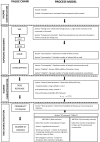Assessing the risk of an emerging zoonosis of worldwide concern: anisakiasis
- PMID: 28287609
- PMCID: PMC5347442
- DOI: 10.1038/srep43699
Assessing the risk of an emerging zoonosis of worldwide concern: anisakiasis
Abstract
Anisakiasis is an emerging zoonosis caused by the fish parasitic nematode Anisakis. Spain appears to have the highest reported incidence in Europe and marinated anchovies are recognised as the main food vehicle. Using data on fishery landings, fish infection rates and consumption habits of the Spanish population from questionnaires, we developed a quantitative risk assessment (QRA) model for the anchovy value chain. Spaniards were estimated to consume on average 0.66 Anisakis per untreated (non-frozen) raw or marinated anchovy meal. A dose-response relationship was generated and the probability of anisakiasis was calculated to be 9.56 × 10-5 per meal, and the number of annual anisakiasis cases requiring medical attention was predicted between 7,700 and 8,320. Monte Carlo simulations estimated post-mortem migration of Anisakis from viscera to flesh increases the disease burden by >1000% whilst an education campaign to freeze anchovy before consumption may reduce cases by 80%. However, most of the questionnaire respondents who ate untreated meals knew how to prevent Anisakis infection. The QRA suggests that previously reported figures of 500 anisakiasis per year in Europe is a considerable underestimate. The QRA tool can be used by policy makers and informs industry, health professionals and consumers about this underdiagnosed zoonosis.
Conflict of interest statement
The authors declare no competing financial interests.
Figures




Similar articles
-
Anisakiasis and Anisakis: An underdiagnosed emerging disease and its main etiological agents.Res Vet Sci. 2020 Oct;132:535-545. doi: 10.1016/j.rvsc.2020.08.003. Epub 2020 Aug 6. Res Vet Sci. 2020. PMID: 32828066 Review.
-
The fishing area as a possible indicator of the infection by anisakids in anchovies (Engraulis encrasicolus) from southwestern Europe.Int J Food Microbiol. 2009 Feb 28;129(3):277-81. doi: 10.1016/j.ijfoodmicro.2008.12.009. Epub 2008 Dec 16. Int J Food Microbiol. 2009. PMID: 19162359
-
Anisakis infection in anchovies (Engraulis encrasicolus) from Iberian waters, southwestern Europe: Post-mortem larval migration.Res Vet Sci. 2023 Apr;157:26-34. doi: 10.1016/j.rvsc.2023.02.007. Epub 2023 Feb 22. Res Vet Sci. 2023. PMID: 36854200
-
[Gastrointestinal anisakiasis. Study of a series of 25 patients].Gastroenterol Hepatol. 2003 Jun-Jul;26(6):341-6. doi: 10.1016/s0210-5705(03)70370-7. Gastroenterol Hepatol. 2003. PMID: 12809570 Review. Spanish.
-
Methods for inactivation of seafood Anisakis larvae and prevention of human anisakiasis: a mini-review.Eur Rev Med Pharmacol Sci. 2023 Jun;27(11):5246-5256. doi: 10.26355/eurrev_202306_32643. Eur Rev Med Pharmacol Sci. 2023. PMID: 37318499 Review.
Cited by
-
A miRNAs catalogue from third-stage larvae and extracellular vesicles of Anisakis pegreffii provides new clues for host-parasite interplay.Sci Rep. 2022 Jun 11;12(1):9667. doi: 10.1038/s41598-022-13594-3. Sci Rep. 2022. PMID: 35690629 Free PMC article.
-
Molecular and Cellular Response to Experimental Anisakis pegreffii (Nematoda, Anisakidae) Third-Stage Larval Infection in Rats.Front Immunol. 2018 Sep 7;9:2055. doi: 10.3389/fimmu.2018.02055. eCollection 2018. Front Immunol. 2018. PMID: 30245697 Free PMC article.
-
Interplay between proinflammatory cytokines, miRNA, and tissue lesions in Anisakis-infected Sprague-Dawley rats.PLoS Negl Trop Dis. 2019 May 15;13(5):e0007397. doi: 10.1371/journal.pntd.0007397. eCollection 2019 May. PLoS Negl Trop Dis. 2019. PMID: 31091271 Free PMC article.
-
Parasites of zoonotic interest in selected edible freshwater fish imported to Australia.Food Waterborne Parasitol. 2021 Dec 3;26:e00138. doi: 10.1016/j.fawpar.2021.e00138. eCollection 2022 Mar. Food Waterborne Parasitol. 2021. PMID: 34977391 Free PMC article.
-
World-wide prevalence of Anisakis larvae in fish and its relationship to human allergic anisakiasis: a systematic review.Parasitol Res. 2020 Nov;119(11):3585-3594. doi: 10.1007/s00436-020-06892-0. Epub 2020 Oct 6. Parasitol Res. 2020. PMID: 33025215
References
-
- EFSA-BIOHAZ. Scientific Opinion on risk assessment of parasites in fishery products. EFSA J. 8, 1543 (2010). - PubMed
-
- Mattiucci S. & D’Amelio S. In Helminth Infections and their Impact on Global Public Health (ed. Bruschi F.) 9783709117, 325–365 (Springer Vienna, 2014).
Publication types
MeSH terms
LinkOut - more resources
Full Text Sources
Other Literature Sources
Medical
Research Materials

